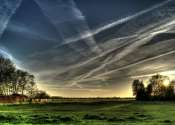Study may explain the source of nitrogen in Earth's atmosphere
Nitrogen makes up approximately 78% of the air we breathe. But scientists have never fully understood how it came to be present in the atmospheres around Earth and other planets.

Nitrogen makes up approximately 78% of the air we breathe. But scientists have never fully understood how it came to be present in the atmospheres around Earth and other planets.
Earth Sciences
Apr 21, 2020
0
22

A new reconstruction of global average surface temperature change over the past 2,000 years has identified the main causes for decade-scale climate changes. The analysis suggests that Earth's current warming rate, caused ...
Environment
Jul 24, 2019
24
969

More than 10 miles into the backcountry of Yellowstone National Park, on the edge of the caldera, lives a high-elevation community so diverse that Montana State University scientists call it "incredible, unique and truly ...
Earth Sciences
Feb 27, 2019
0
230

UC Berkeley scientists have obtained more precise dates for the Deccan Traps volcanic lava flows, linking peak activity more closely to the asteroid or comet impact 66 million years ago and the coincident mass extinction. ...
Earth Sciences
Feb 21, 2019
64
265

A team of researchers from the National Center for Atmospheric Research, the Pacific Northwest National Laboratory and Cornell University has found via modeling that injecting sulfate aerosols into the stratosphere could ...

Guatemala's deadly Fuego volcano erupted anew early Friday, unleashing a 600-meter flow of lava and sending clouds of ash spiralling into the sky.
Environment
Oct 12, 2018
0
560

The chemical composition of gases emitted from volcanoes—which are used to monitor changes in volcanic activity—can change depending on the size of gas bubbles rising to the surface, and relate to the way in which they ...
Earth Sciences
Aug 6, 2018
0
71

Lava crossed a key highway in the mostly rural district of the Big Island where Kilauea volcano was erupting, local authorities in Hawaii said Tuesday.
Environment
May 30, 2018
0
6

Professor Tamsin Mather, a volcanologist in Oxford's Department of Earth Sciences reflects on her many fieldwork experiences at Massaya volcano in Nicaragua, and what she has learned about how they effect the lives of the ...
Earth Sciences
Jan 29, 2018
0
18

Geoengineering is a catch-all term that refers to various theoretical ideas for altering Earth's energy balance to combat climate change. New research from an international team of atmospheric scientists published by Geophysical ...
Earth Sciences
Jul 24, 2017
18
221